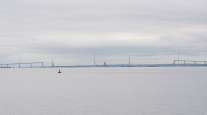Senior Reporter
Fixing Supply Chain Won’t Be Easy, Experts Say

[Stay on top of transportation news: Get TTNews in your inbox.]
Fixing the broken supply chain will take time and patience, substantial amounts of money, imagination by key leaders in the transportation and logistics industry, and significant policy changes.
Those are the conclusions of experts closely watching the upcoming holiday shopping season, but, as they said, the rush to buy items amplifies how stretched the system is.
“What we have is a storm within a storm,” University of Houston Logistics Professor Margaret Kidd told Transport Topics. “Consumers have insatiable demand, and consumers are spending. E-commerce numbers through the second quarter this year are up 57% from two years ago.”
What we have is a storm within a storm.
University of Houston Logistics Professor Margaret Kidd
Council of Supply Chain Management Professionals President Mark Baxa said the global supply chain was quite fragile before COVID-19 and that Trump administration tariffs against China in 2018 shocked the supply chain.
“It was not long after the introduction of the tariffs that we faced this global pandemic, and that was a crushing impact.”
Kidd said the supply chain challenges are exacerbated by the enormous amount of cargo still to be unloaded at the ports of Los Angeles and Long Beach — the nation’s biggest, respectively. Sixty-two ships were waiting to be unloaded on Oct. 12, and some have waited for as long as 24 days to obtain a berth.
Both ports recently announced plans to eventually expand to 24/7 operations.
However, Port of Long Beach Executive Director Mario Cordero told TT he would be pleased with a 16-hour, five-day operation in the future, which he said would significantly improve efficiency.
“U.S. imports from Asia range between 36% to 40% to Los Angeles and Long Beach. That is not sustainable. They are landlocked, and their warehouse vacancy rate is under 2%. There is nowhere to go,” Kidd said.
Kidd said several things must happen over the next few years, including bringing more manufacturing closer to the United States.
“If we look at economic development in Guatemala, El Salvador and Honduras and parts of the Caribbean, we would diversify some of this risk away from China and Southeast Asia,” she said. “And I include Mexico.”
Kidd said the supply chain problems — including Vietnam and China’s expanding power supply problems — are being made worse by the COVID-19 pandemic’s spread in Asia.
Kidd also said shippers need to diversify where they send cargo on both coasts, utilizing smaller facilities.
“At some point, you have a national security issue where so much of your trade goes into one particular place,” Kidd said. “The port leaders on the West Coast are doing a great job, but they’re landlocked. Ports like Houston, Mobile, Freeport, the Southeast Atlantic ports, you have connectivity to the entire country.”
Kidd echoed what officials at the American Association of Port Authorities convention in Austin, Texas, recently said when they stressed that to become more efficient ports will also have to share more information and cooperate to a much greater extent than they are now.
Ohio State University Logistics Professor Terry Esper told TT he’s encouraged that federal and local officials seek to spend more than $1 trillion on infrastructure to rebuild highways, roads, bridges and ports.
“We don’t have an infrastructure that was prepared for this,” said Esper, who noted that in 2018 e-commerce represented 13.8% of retail sales, and that figure is expected to grow to nearly 26% by 2025. “This is not just a holiday thing. This is not just a demand spike thing. This is about the economy being able to function.”
Adding to the supply chain challenges, the U.S. Department of Labor said in July the warehouse and transportation industry was short a record 490,000 employees, a gap that experts predict will widen in coming months. Included in that number is the 60,000-plus truck drivers needed to fill some of those positions, according to American Trucking Associations.
Today, the Biden-Harris Administration is convening business leaders, port leaders, and union leaders to discuss challenges at ports across the US and announce commitments to move more goods faster, and strengthen the resiliency of our supply chains.
https://t.co/U8HIoURqfh — The White House (@WhiteHouse) October 13, 2021
“These are not easy jobs to fill,” CSCMP’s Baxa said. “Let’s continue to find ways that make work-life balance as favorable as possible, and we’ll attract more people to the industry. We need to improve work-life balance, support driver health and working conditions and compensation. We need to keep working at it.”
Esper says to encourage more people to consider transportation-related careers employers may have to increase spending on technology as well as higher salaries and benefits.
“Part of our supply chain constraint is labor. If you want access to labor, you’re going to start to have to look at what you pay,” he said. “We also need to look at technology, and now is the time to consider more investments in more automated operations, robotics and such. There is a business case for this, and the writing is on the wall.”
Want more news? Listen to today's daily briefing below or go here for more info:





